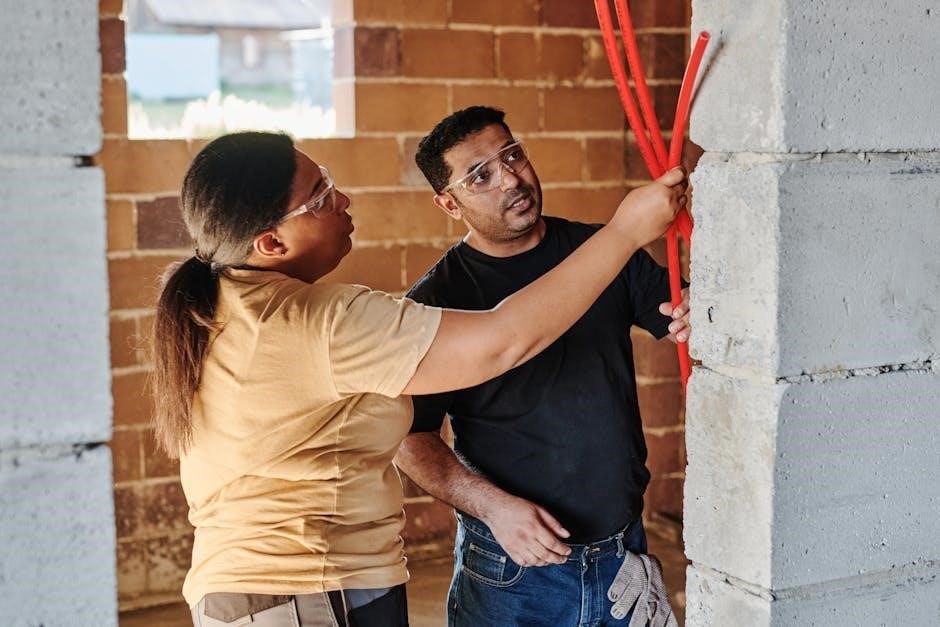Mechanical Engineering Reference Manual⁚ PE Exam Preparation
The Lindeburg Mechanical Engineering Reference Manual (MERM) is a widely used resource for preparing for the NCEES PE Mechanical Exam. This comprehensive manual offers focused study for success, covering key exam topics such as HVAC and Refrigeration, Machine Design and Materials, and Thermal and Fluid Systems. It’s renowned for its step-by-step solutions and detailed examples, directly addressing complex topics using NCEES-compliant equations and strategies for efficient problem-solving. The MERM’s updated editions reflect the latest exam specifications and are tailored for computer-based testing.
Understanding the PE Exam
The Professional Engineering (PE) exam is a rigorous assessment of engineering competency, requiring a minimum of four years of post-college work experience. It’s designed to ensure a minimum level of proficiency, making it crucial to approach preparation strategically. The exam’s difficulty varies depending on individual familiarity with the content, aligning more closely with one’s current work experience. Passing the exam often hinges on choosing the appropriate exam type which directly supports individual career goals, whether it’s a promotion within a current role or a transition into a new field. Therefore, selecting the exam that best aligns with career aspirations is more important than simply targeting the easiest option. Successful preparation necessitates a deep understanding of the exam’s format, content areas, and the specific reference materials permitted during the examination.
Choosing the Right PE Exam for Your Goals
The NCEES PE Mechanical Exam is offered in three distinct disciplines⁚ HVAC and Refrigeration, Machine Design and Materials, and Thermal and Fluid Systems. Carefully consider your career trajectory when selecting the appropriate exam. If your goal is advancement within your current role, choose the exam that most closely aligns with your daily responsibilities and expertise. For instance, if you primarily work on HVAC systems, the HVAC and Refrigeration exam would be the most logical choice. Similarly, those specializing in machine design should opt for the Machine Design and Materials exam. Conversely, if you aim for a career change, choose the exam that will best prepare you for your desired new field. Thoroughly researching each exam’s content and aligning it with your professional aspirations is vital for maximizing your chances of success. Don’t solely focus on perceived ease; select the exam that best supports your long-term career objectives.
Key Exam Topics Covered in the MERM
The Lindeburg MERM provides comprehensive coverage of the core subjects tested in the NCEES PE Mechanical Exam. These include, but are not limited to, thermodynamics, fluid mechanics, heat transfer, and power cycles. Within these broad categories, the manual delves into specific areas crucial for exam success. For example, under thermodynamics, you’ll find detailed explanations of concepts like entropy, enthalpy, and the various thermodynamic processes. Fluid mechanics sections cover topics ranging from pipe flow and pressure drop calculations to the principles of fluid statics and dynamics. Heat transfer principles are thoroughly examined, including conduction, convection, and radiation. Finally, the manual provides a robust treatment of power cycles, encompassing both gas and vapor power systems. Each topic is presented with numerous solved examples and problems to reinforce understanding and build confidence for exam day. The MERM’s organization ensures efficient study, focusing on the most relevant and frequently tested concepts.
Utilizing the Lindeburg MERM
Mastering the Lindeburg MERM involves understanding its structure and effectively using its problem-solving approach and detailed step-by-step solutions to build confidence for the PE exam.
Problem-Solving Strategies within the Manual
The Lindeburg MERM excels in guiding examinees through effective problem-solving techniques crucial for success on the PE Mechanical exam. The manual doesn’t just present formulas; it emphasizes a structured approach. Each problem is broken down into manageable steps, clearly outlining the thought process required to reach a solution. This step-by-step methodology is invaluable for building confidence and avoiding common pitfalls. The MERM often uses diagrams and illustrations to enhance understanding, making complex concepts more accessible. Furthermore, the manual stresses the importance of identifying the core principles governing each problem before applying relevant formulas or equations. This approach helps develop a strong conceptual foundation, enabling you to tackle unfamiliar problem types effectively. By understanding the underlying principles, you can apply your knowledge to diverse scenarios, improving your overall problem-solving skills and exam performance. The emphasis on understanding the method and logic behind the solutions is a key strength of the MERM’s problem-solving strategy.
Effective Use of Equations and Formulas
Mastering the effective use of equations and formulas is paramount for success on the PE Mechanical exam, and the Lindeburg MERM provides invaluable guidance in this area. The manual meticulously presents numerous equations relevant to the exam, ensuring comprehensive coverage of all key topics. However, simply memorizing formulas is insufficient; the MERM emphasizes understanding their derivation and the underlying principles. This approach promotes retention and allows for flexible application in diverse problem scenarios. The book provides numerous worked examples illustrating how to select and apply the appropriate formula for a given problem. It also highlights common mistakes and misconceptions associated with formula usage, helping to avoid errors during the exam. Furthermore, the MERM stresses the importance of unit consistency and dimensional analysis. By meticulously checking units throughout the solution process, examinees can significantly reduce the likelihood of calculation errors. The integration of unit analysis into the problem-solving strategy reinforces good engineering practice and contributes to more accurate and reliable solutions.
Step-by-Step Solutions and Examples
The Lindeburg MERM distinguishes itself through its detailed, step-by-step solutions and numerous illustrative examples; These aren’t just answers; they’re comprehensive guides to the problem-solving process. Each example problem meticulously outlines the approach, clearly demonstrating the application of relevant formulas, concepts, and engineering principles. The step-by-step breakdown allows examinees to follow the logical progression of each solution, fostering a deeper understanding of the underlying principles rather than mere rote memorization. This approach is particularly beneficial for complex problems, breaking them down into manageable steps, thereby reducing the risk of errors and improving comprehension. The inclusion of diverse problem types mirrors the complexity and variety encountered in the actual PE exam. This comprehensive coverage builds confidence and ensures readiness for a wide range of exam questions. Moreover, the clear explanations accompanying each solution provide valuable insights into effective problem-solving strategies, significantly enhancing the learning experience.
Supplementing the MERM
While the MERM is comprehensive, supplementing it with the NCEES Handbook and additional practice exams enhances exam preparation. This ensures familiarity with all permitted resources and strengthens problem-solving skills.
NCEES Reference Handbook Integration
The NCEES Reference Handbook is the only permitted resource during the PE Mechanical exam; therefore, integrating it with your MERM study is crucial. Familiarize yourself with its layout, formulas, tables, and charts before exam day. The handbook contains essential data and equations that you will need to solve problems efficiently during the exam. Practice solving problems using only the handbook’s information to simulate the actual testing conditions. This will significantly reduce anxiety and improve your performance. Understanding how to quickly locate and apply the necessary information within the handbook is a key aspect of test-taking success. Don’t merely passively review the handbook; actively use it to solve problems from the MERM or other practice materials. By actively engaging with the NCEES Reference Handbook during your preparation, you will build confidence and improve your ability to efficiently use the resource under pressure, leading to a much more successful exam experience. Mastering the navigation and utilization of this handbook is paramount for efficient problem-solving during the examination.
Additional Recommended Resources
While the MERM provides a comprehensive foundation, supplementing your studies with additional resources can significantly enhance your preparation. Consider the ASHRAE handbooks, especially if focusing on the HVAC and Refrigeration section of the exam; these provide detailed information on HVAC systems and equipment. Other valuable resources include specialized textbooks focusing on specific areas like fluid mechanics, thermodynamics, or machine design, depending on your weaker areas. Online forums and study groups offer opportunities for peer learning and clarifying challenging concepts. Access to practice problems beyond those within the MERM is also crucial; these offer varied problem types and reinforce your understanding of different concepts. Remember to prioritize resources that align with the NCEES exam specifications to ensure your study efforts directly address the exam’s content. Don’t feel obligated to use every resource available; focus on a select few that best suit your learning style and areas needing improvement. A well-structured approach to using supplementary materials, combined with focused study using the MERM, will significantly enhance your chances of success.
Practice Exams and Review Materials
Beyond the example problems within the Lindeburg MERM, dedicated practice exams are invaluable for assessing your preparedness and identifying areas needing further review. NCEES itself offers practice exams; these are crucial for familiarizing yourself with the exam format, question style, and time constraints. Numerous publishers also provide comprehensive practice exam sets mirroring the difficulty and content of the actual PE Mechanical exam. These often come with detailed solutions, allowing you to understand not only the correct answer but also the underlying reasoning and problem-solving approach. Reviewing these solutions is as important as taking the practice exams themselves. Consider using practice exams strategically; start with a broad overview, then focus on specific topics based on your performance. Don’t just aim for correct answers; analyze your mistakes to pinpoint weak areas in your understanding. By consistently using practice exams and thoroughly analyzing your performance, you can effectively identify and address knowledge gaps, ultimately boosting your confidence and exam readiness.



About the author